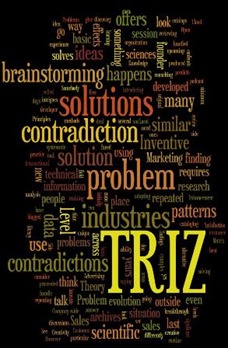The last few days, I have blogged about TRIZ – For People Who Struggle with Open Innovation and Getting Started with TRIZ, as a way of introducing my upcoming podcast with Ellen Domb, founder of the PQR Group, a TRIZ training & consulting organization.
What has intrigued me about the TRIZ process is that it is a systematic way of creating breakthrough ideas. It is a set of tools that go beyond your typical brainstorming session. Though brainstorming has its place, I am not convinced even after a quite few years in participating in brainstorming sessions, that it ever produced all the original ideas that we thought it would. In my experience, it was the second time around where people would come back after thinking on their own that many of the best ideas surfaced. Would they have been attained without a brainstorming session, I don’t know.
it was the second time around where people would come back after thinking on their own that many of the best ideas surfaced. Would they have been attained without a brainstorming session, I don’t know.
TRIZ (Theory of Inventive Problem Solving) offers an alternative. It also offers something that intrigues me a great deal. An “Inventive” Problem solving that by definition can be said to be a solution that solves a contradiction.
In most of my discussions, I talk about co-creation and partnering with customers. All the Service Dominant Logic talk where value is determined by use. But what happens, when you are in a transactional situation? What happens when you are not on the same side of the fence with a prospect? What happens when there is a contradiction?
In Sales and Marketing, how do we handle contradictions? In the past, I relied on the Theory of Constraints and using the Evaporating Cloud (How to See the Other Side of a Conversation) or a 2 x 2 Matrix (What Type of Thinking Solves Dilemmas). TRIZ offers a unique opportunity to look at things differently.
The founder of TRIZ, Genrich Altshuller initially selected 40,000 patents from 200,000 or so that were representative of inventive solutions. Without going into too many details, he used this information to form the basis of where to find examples. From the Triz Journal archives:
Somebody someplace has already solved this problem (or one very similar to it.)
Creativity is now finding that solution and adapting it to this particular problem.
They go on to say:
The research has proceeded in several stages during the last sixty years. The three primary findings of this research are as follows:
- Problems and solutions are repeated across industries and sciences. The classification of the contradictions in each problem predicts the creative solutions to that problem.
- Patterns of technical evolution are repeated across industries and sciences.
- Creative innovations use scientific effects outside the field where they were developed.
Much of the practice of TRIZ consists of learning these repeating patterns of problems-solutions, patterns of technical evolution and methods of using scientific effects, and then applying the general TRIZ patterns to the specific situation that confronts the developer.
The archives that have been developed in TRIZ are enormous. They have 40 Inventive Principles in Customer Satisfaction Enhancement and another in Marketing, Sales and Advertising.
I am not saying you need to run out and use this information. However, I think at a minimum we should consider how we are cataloging the data we create for others to solve problems with. Do we have a library that catalogs our sales and marketing data that can be accessed by the problem we have or the solution that we think will work. Many of us will answer yes. In TRIZ that would be for Level 1 (basic & routine improvements) in The Five Levels of Inventiveness, which is significant since that level solves many of the problems. This portion of TRIZ requires us to look first at easier solutions, than tackle harder ones through analysis of data outside of our immediate areas reviewing other solutions that took place in other industries, new discoveries and so forth. Level 5 is for highly innovate and for something that requires new scientific discovery.
The secret to finding these solutions is that the database directly links the type of contradiction to the most probable principle for the solution of that problem. When your sales people are faced with a contradiction, do they have the ability to review similar contradictions even at Level 1 for the most basic improvement? Can they see how this contradiction was handled in other industries? Is your Knowledge base collected Company-wide? Industry-wide? Are similar contradictions looked for in other industries? In Nature?
I find that many companies may answer yes to these questions. However, that yes can typically be only applied to technical or product answers. Seldom can an answer be found based on Emotion or Social Contradictions. Value is a three-legged stool based on function, social and emotional components. Each component will weigh differently depending on the circumstances and clients. Contradiction can happen in one or all of them. What happens if you re-consider the questions?
